PM Images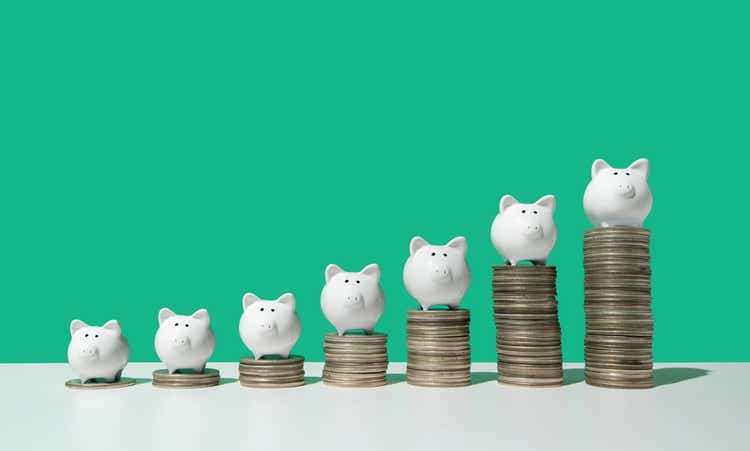
It was fun while it lasted, but the positive streak was broken after only 1 week. After 13 consecutive weeks of finishing in the red, the Dividend Harvesting Portfolio finished in the black in week 92, only to have the winning streak snapped and a new streak of closing in the red begin. While the Dividend Harvesting portfolio closed down -2.21% (-$205.09) in week 93, it broke the $700 level of projected annual dividends. The S&P 500 is still down -17.97% YTD, and the CPI print this week could spark a holiday rally. Regardless of what occurs, this portfolio is being constructed with a long-term vision, and its goals of mitigating risk by withstanding unexpected volatility continue to be achieved. We will see what occurs through the remainder of 2022, but I will continue deploying capital weekly.
The Dividend Harvesting Portfolio finished week 93, valued at $9,094.91, down -2.21% from my invested capital. My projected annual income grew 1.87% ($12.89) to $703.25, and got a step closer to the next goal of generating $1,000 of annual dividend income. In week 93, 13 companies generated $14.58 of dividend income, and this portfolio looks as if it will produce dividends each week throughout the year. I added 1 share to New York Community Bank (NYCB), Owl Rock Capital Corporation (ORCC), Global X S&P 500 Covered Call ETF (XYLD), and the BlackRock Science and Technology Trust (BST) in week 93. As there are 3 weeks remaining in 2022, I believe that the Dividend Harvesting Portfolio will exceed $725 in projected annual income and be positioned to either capitalize on a market recovery in 2023 or continue mitigating downside risk and producing weekly income.
I allocate capital toward big tech, funds, dividends, and growth outside of my retirement accounts. These are not my only investments, but I did open a separate account, so I could easily track and document this series. I intentionally created broad diversification throughout the Dividend Harvesting portfolio so I could benefit from sector rotations and mitigate my downside risk. Investors who are too exposed to growth companies or large-cap tech have gotten crushed as the investment landscape changes. On the growth and tech side of my investments, I am feeling the pain as some of my favorite companies, including Alphabet (GOOGL, GOOG), Amazon (AMZN), and Meta Platforms (META), have been taken to the woodshed.
I am going to address a question that continues to surface. I am not trying to beat the market with this portfolio. I love index funds and am invested in several index funds. I love dividend investing due to the stream of cash flow it generates. I don’t want 100% of my assets outside of real estate tied to an S&P index fund. I have created a personal investment strategy that works to achieve my investment goals, and having a stream of income generated from dividends is part of my investment strategy. Low-cost index funds are one of the best investments anyone can make in my opinion, and the Dividend Harvesting portfolio is not meant to be a substitute for an index fund. I have read many questions about dividend investing and wanted to start a portfolio from the ground up and document its progress to disprove many misconceptions, including that you need a large amount of seed capital to make dividend investing work for you.
This series has never been about hitting a target yield, generating a certain amount of profit, or beating the market. I had two specific goals with this series. The first was to create a blueprint for constructing a dividend portfolio by documenting the journey starting from the beginning. The second goal was to illustrate how allocating capital each week toward investing, regardless of the amount, would be beneficial in the long run.
Too many people are under the illusion that you need tens of thousands or even hundreds of thousands to benefit from investing. Instead of using my real dividend portfolio as an example, I decided to start a new account, fund it with $100, and add $100 weekly, providing a step-by-step guide to dividend investing. This methodology doesn’t have to be used for dividend investing, and it could be as simple as an S&P index fund or a Total Market fund. Hopefully, this series is inspiring people to invest in their future to attain financial freedom.
A Historical Recap of the Dividend Harvesting Portfolio’s Investment Principles and Historical Performance
Investment Objectives
- Income generation
- Downside mitigation through diversification
- Capital appreciation
Below are the fundamental rules I have put in place for this Portfolio:
- Allocate $100 weekly to this Portfolio
- Only invest in dividend-producing investments
- No position can exceed 5% of the Portfolio
- No sector can exceed 20% of the Portfolio
- All dividends & distributions are to be reinvested
Below is a chart that extends from week 1 through the current week to illustrate the Dividend Harvesting Portfolio’s Progression
- Blue line is my initial investment $100 in week 1, $1,000 in week 10, etc.
- Red line is the account value at the end of each week
- Yellow line is the annual dividend income the Dividend Harvesting Portfolio was projected to generate after that week’s investments and dividends reinvested
The Dividend Harvesting Portfolio Section
Here is how much dividend income is generated per investment basket:
- Equities $212.85 (30.27%)
- ETFs $175.36 (24.94%)
- CEFs $135.40 (19.25%)
- REITs $135.15 (19.22%)
- BDCs $44.49 (6.33%)
Steven Fiorillo Steven Fiorillo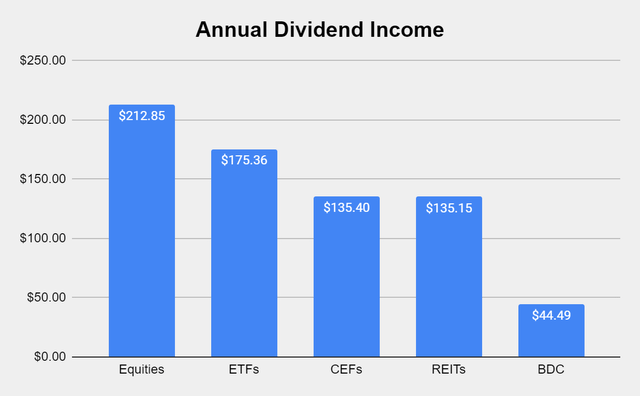
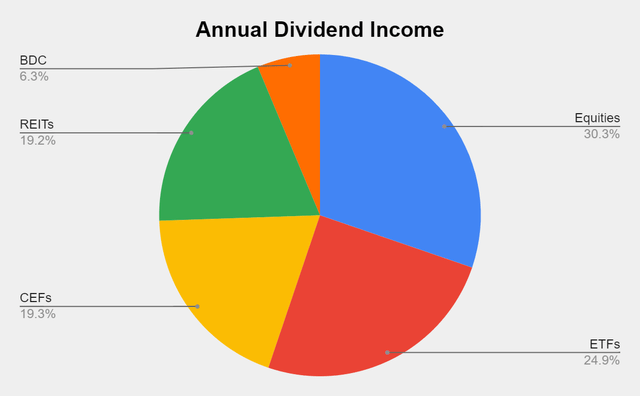
Collecting dividends can serve many functions in a portfolio. Some investors utilize dividends to supplement their income and live off. I am building a dividend portfolio for myself 30 years into the future. In 2022, I have collected $452.39 in dividend income from 495 dividends across 49 weeks. This has allowed the Dividend Harvesting portfolio to stay in the black while growing the snowball effect.
These dividends allow me to gain additional equity in my investments while increasing my future cash flow in down markets. This style of investing isn’t for everyone, but if you’re looking to generate consistent cash flow while mitigating downside risk, this method has worked for me. I am hoping to collect between $450 and $500 in dividends in 2022, which will be reinvested, and finish the year generating >$700 in annual dividends.
I am interested to see how the dividend income in December ends, as there has been a significant uptrend in the YoY monthly dividend income. I am excited to see what this chart looks like in several years from now.
I haven’t added new positions since week 90, and the Dividend Harvesting Portfolio has 604 individual dividends flowing through its portfolio on a weekly basis.
Steven Fiorillo, Seeking Alpha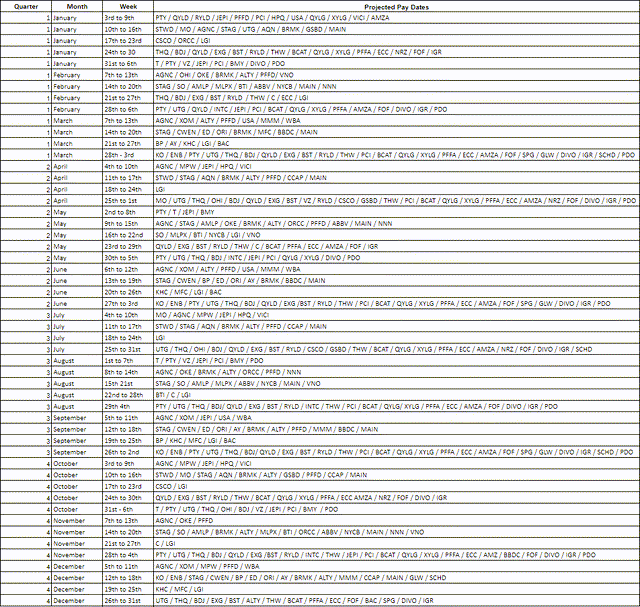
The goal of generating enough income from the dividends to purchase an additional share per year has been the never-ending project of this portfolio. There are now 15 total positions generating at least 100% of their share value in dividends within the Dividend Harvesting portfolio. I think that it is a realistic possibility that I can add 4 more companies to this group by the end of 2022.
Steven Fiorillo, Seeking Alpha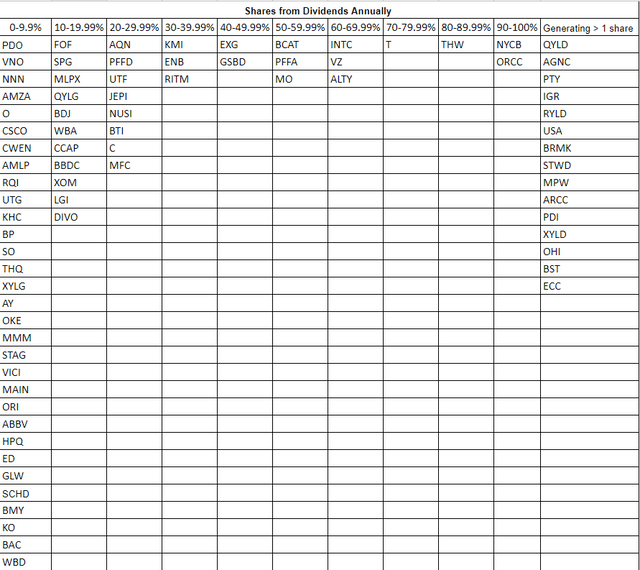
The Dividend Harvesting Portfolio Composition
Many of the readers have asked if I could break down the individual positions within these sectors. I created pie charts for each individual sector and have illustrated how much each position represents of that sector of the Dividend Harvesting portfolio. Since I only have 1 position in Food & Staple Retailing and Industrials, I did not make a chart for those. 3M (MMM) and Walgreens Boots Alliance (WBA) represent 100% of those sectors. The charts will follow the normal portfolio total I have constructed. Please keep the ideas coming, as I am happy to add as much detail to this series as I can.
Steven Fiorillo, Seeking Alpha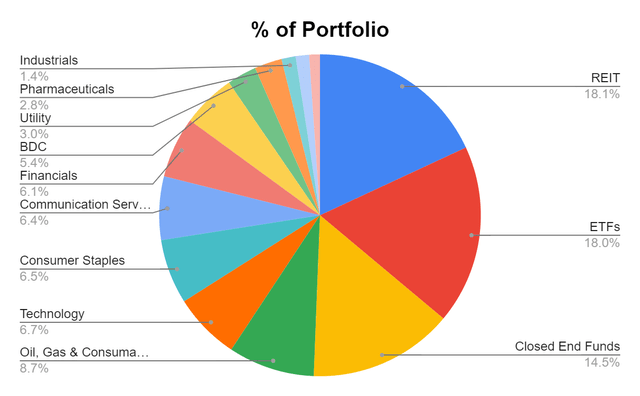
In week 92, REITs remained the largest segment within the Dividend Harvesting Portfolio. Individual equities make up 43.96% of the portfolio and generate 30.27% of the dividend income, while exchange-traded funds (“ETFs”), closed-end funds (“CEFs”), real estate investment trusts (“REITs”), business development companies (“BDCs”), and exchange-traded notes (“ETNs”) represent 56.04% of the portfolio and generate 69.73% of the dividend income.
I have a 20% maximum sector weight, so when a singular sector gets close to that level, I make sure capital is allocated away from that area to balance things out. In 2022, I will make an effort to even out these portfolio percentages. As more capital is deployed, the bottom half of the portfolio weighting will increase.
|
Industry |
Investment |
Portfolio Total |
% of Portfolio |
|
REIT |
$1,643.33 |
$9,094.91 |
18.07% |
|
ETFs |
$1,635.59 |
$9,094.91 |
17.98% |
|
Closed End Funds |
$1,320.60 |
$9,094.91 |
14.52% |
|
Oil, Gas & Consumable Fuels |
$788.90 |
$9,094.91 |
8.67% |
|
Technology |
$610.64 |
$9,094.91 |
6.71% |
|
Consumer Staples |
$591.33 |
$9,094.91 |
6.50% |
|
Communication Services |
$579.17 |
$9,094.91 |
6.37% |
|
Financials |
$557.40 |
$9,094.91 |
6.13% |
|
BDC |
$489.95 |
$9,094.91 |
5.39% |
|
Utility |
$269.35 |
$9,094.91 |
2.96% |
|
Pharmaceuticals |
$250.54 |
$9,094.91 |
2.75% |
|
Industrials |
$129.91 |
$9,094.91 |
1.43% |
|
Food & Staple Retailing |
$121.82 |
$9,094.91 |
1.34% |
|
Independent Power & Renewable Electricity Producers |
$98.72 |
$9,094.91 |
1.09% |
|
Cash |
$7.68 |
$9,094.91 |
0.08% |
Steven Fiorillo, Seeking Alpha Steven Fiorillo, Seeking Alpha Steven Fiorillo, Seeking Alpha Steven Fiorillo, Seeking Alpha Steven Fiorillo, Seeking Alpha Steven Fiorillo, Seeking Alpha Steven Fiorillo, Seeking Alpha Steven Fiorillo, Seeking Alpha Steven Fiorillo, Seeking Alpha Steven Fiorillo, Seeking Alpha Steven Fiorillo, Seeking Alpha Steven Fiorillo, Seeking Alpha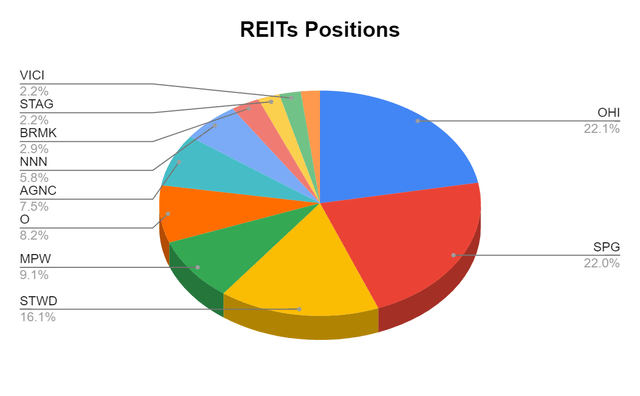
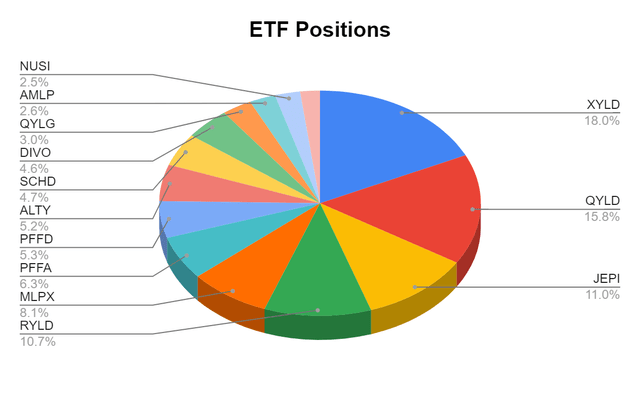
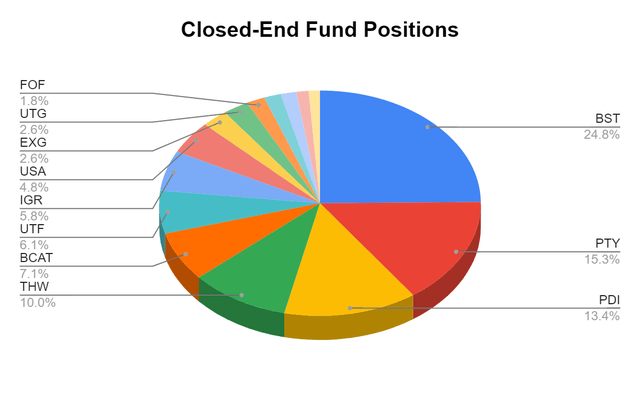
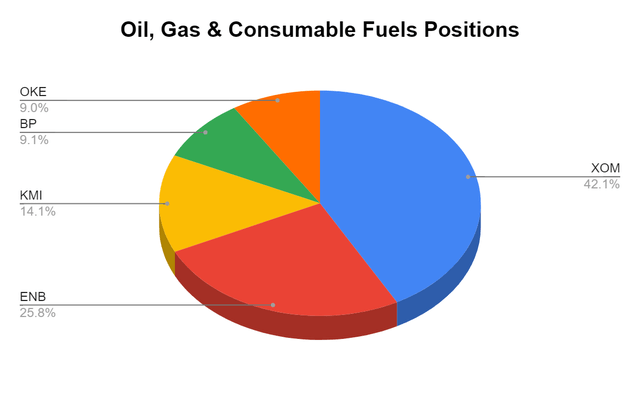
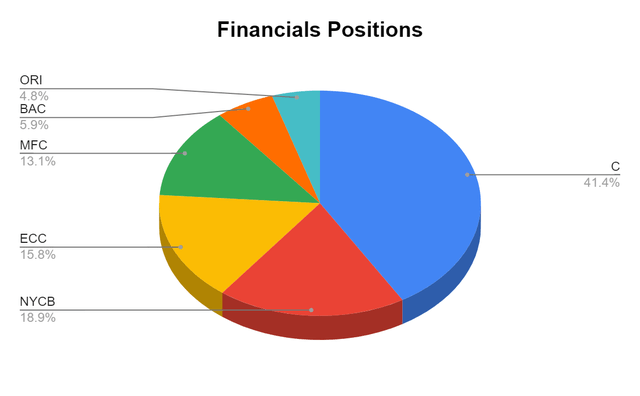
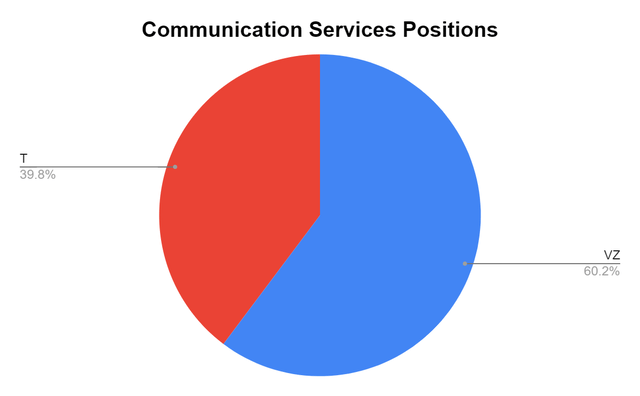
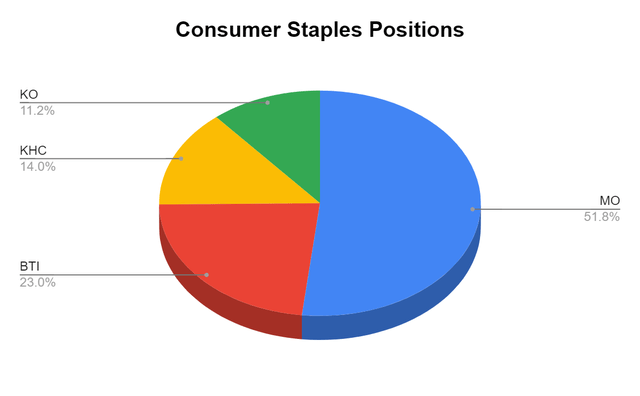
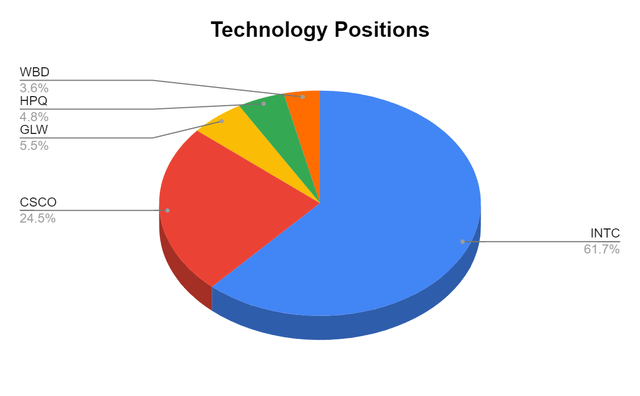
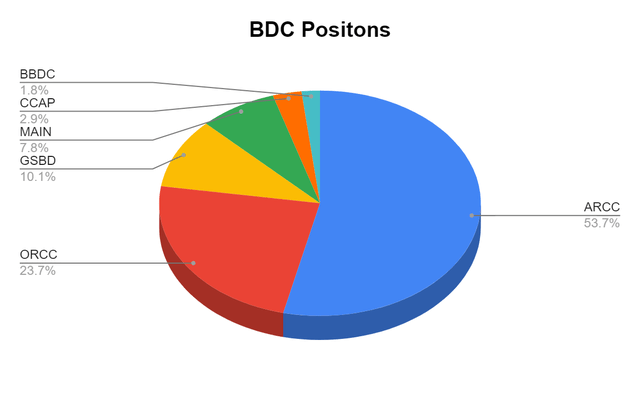
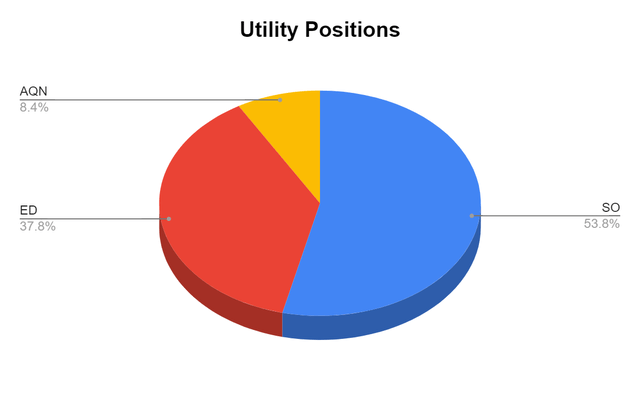
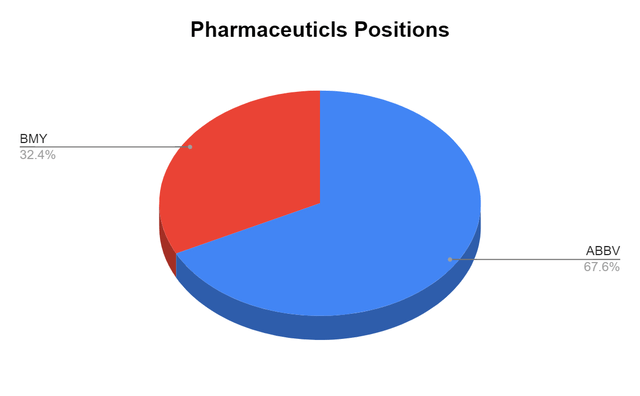
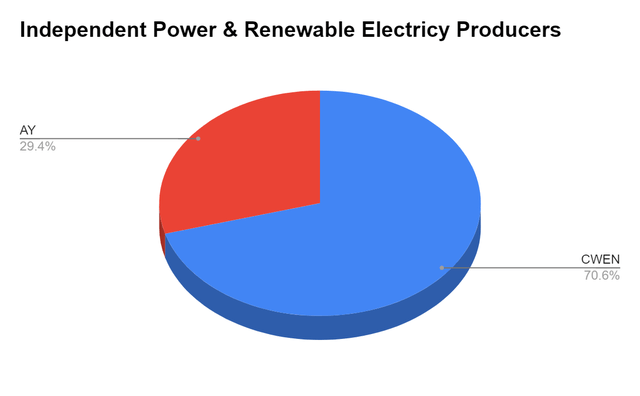
In week 93, Intel Corporation (INTC) remained the largest position in the Dividend Harvesting Portfolio, but its overall percentage continues to decline. At one point INTC was close to a 5% position which was my threshold and since then has declined to 4.14%. I am trying to even the portfolio out, and I suspect that overtime this will occur.
Steven Fiorillo, Seeking Alpha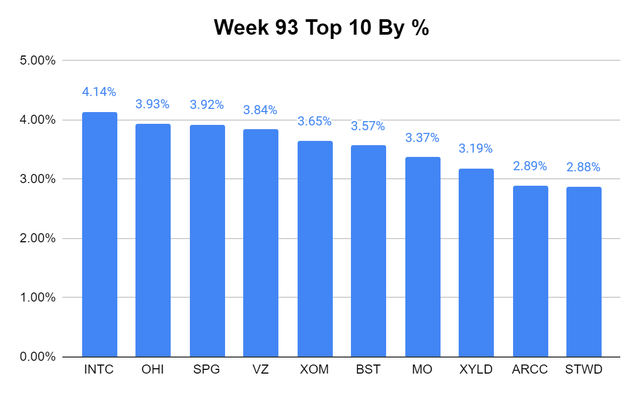
Week 93 additions
In week 93, I added an additional share to the following positions:
- New York Community Bank (NYCB)
- Owl Rock Capital Corporation (ORCC)
- Global X S&P 500 Covered Call ETF (XYLD)
- BlackRock Science and Technology Trust (BST)
New York Community Bank
- I recently wrote an article on why I still believe NYCB is still undervalued (can be read here). NYCB is now generating 96.2% of its share price through annual dividends, and I am hoping to bring this into the 100% category next week. I think NYCB is ripe for capital appreciation in 2023 while generating strong dividend yields.
Owl Rock Capital Corporation
- ORCC has become one of my favorite BDC’s, as it looks to be undervalued compared to others in its space. ORCC offers a double-digit yield and is implementing buybacks in addition to special dividends. This is a company I plan on adding to continuously.
Global X S&P 500 Covered-Call ETF
- XYLD is now past the 100% threshold of generating a share from its dividends, and I am going to curtail adding to it for a while.
BlackRock Science and Technology Trust
- BST has also exceeded the 100% threshold for generating an additional share from its dividends, and I plan on focusing on other positions going forward.
Week 94 Gameplan
In week 94, I am planning on adding to ORCC and NYCB again while adding another share to AT&T (T) and Tekla World Healthcare Fund (THW). Depending on how much capital I have left over, I will either allocate it toward T and THW, or add another share of Verizon (VZ) or Altria Group (MO).
Conclusion
We’re closing in on the final weeks of 2022, and I am quite pleased with how the Dividend Harvesting Portfolio has held up. I am excited to get the first calendar year’s worth of data, and over the next several years, I plan on writing YoY comparison articles. Please leave any suggestions for new positions or new sections in the article series below. I think the Dividend Harvesting Portfolio is well-positioned for any investment environment in 2023, and I plan on continuing to document the process for years to come.


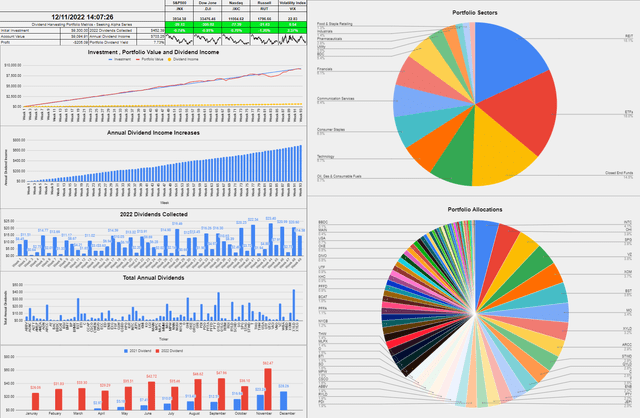
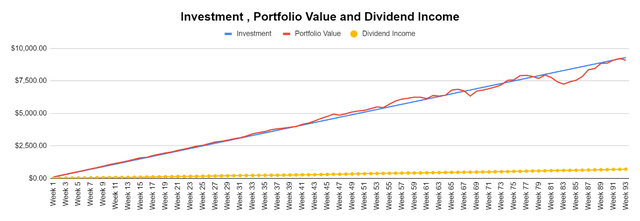
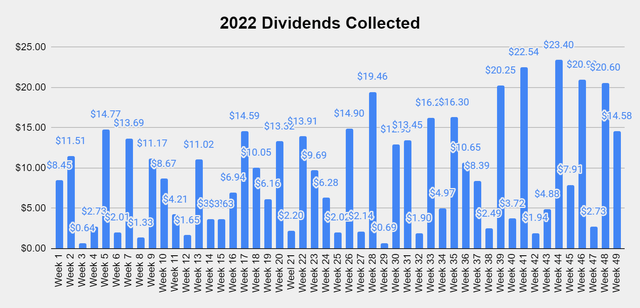
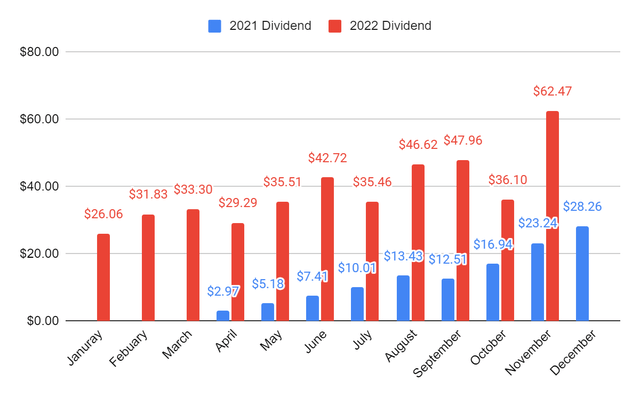
Be the first to comment